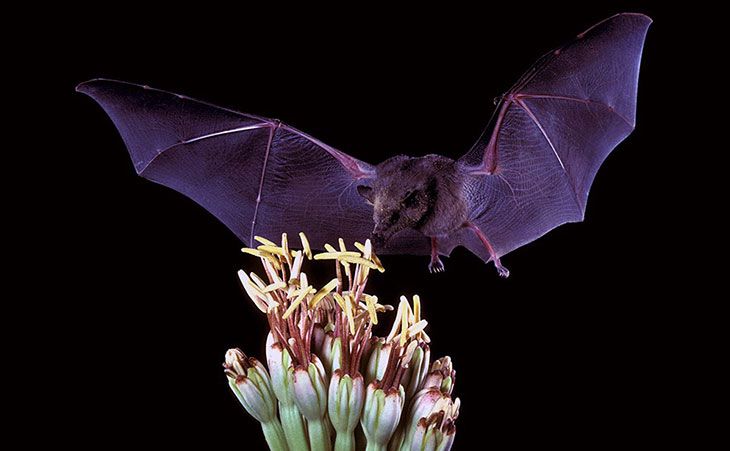The Benefits of Bats

Another misconception is that bats are rodents. They’re actually nocturnal mammals, along with coyotes, hamsters and a host of others. Bats do not chew wood, plaster, drywall or wiring. What they can do is squeeze through an opening the size of a bottle cap and leave guano and urine to accumulate and damage insulation, drywall, eventually rotting interior wood. The idea is to give them a more attractive domicile near the garden so they turn their little bat nose up at your house eaves.
Of course, you don’t want to be attracting vampire bats to your domain. (They’re native to Mexico, Central America, and South America, anyway, so you really don’t need to worry.) The type you’re most likely to encounter in North America is the Vespertilionidae. At least 32 species of this family are found here. You’ll recognize them as the small-to-medium dark brown kind that hang in trees and caves at night, and hibernate in winter. These are the bats you will purposefully attract bats to your backyard, and there are several good reasons to do so:
Pollination. Bats are among the most effective pollinators on Earth. They’re attracted to nectar, as are bees and birds — they just work a different shift. In the course of their nighttime travels, they carry pollen from plant to plant, some of which are actually dependent upon bats for pollination (most notably agave, the necessary ingredient in tequila).
Free super-fertilizer. Bat droppings, or guano, is an especially rich nutrient source for plants, and is a wonderful soil builder. In addition to being a nearly ideal high-nitrogen fertilizer (10-3-1), it contains beneficial microorganisms and fungi to stimulate root growth, acts as a natural fungicide and is an effective control for nematodes.
(Incidentally, bats and their guano are also helping to restore the rain forests by way of the seeds which are inadvertently planted when that guano is dropped on the fertile soil. Locals in Brazil refer to them as the “farmers of the tropics”.)
Bug population control. Mosquito-borne diseases like the West Nile and Zika viruses, dengue and malaria are all a present danger to humans. Thankfully, bats thrive on mosquitoes. According to Mother Earth News, a single bat can eat up to 1,200 mosquitoes an hour, and up to 8,000 in one single overnight period! Bats also take care of a variety of beetles and moths. Clearly, having a bat house in your yard can significantly reduce the need for chemical pesticides.

Attracting bats is easy

Install a bat house. Most all well-designed bat houses have a roof and a bottom entrance; the key is placing it correctly. We suggest hanging the bat house on a pole (vs. nailing it to a tree), approximately 15 feet off the ground, with a south/southeast exposure. Hang bat houses away from trees, but near water if possible. (Many insects, especially mosquitoes, breed in water and a pond is a great attractor for bats. Even a bird bath will do.)
If it’s not a hazard, leave dead trees be. Bats love to hide behind separated bark and in the crevices of split trees, and will form colonies there if left to their own devices. A decaying tree will also beckon insects to provide food for the bats.
Bats also have an affinity for certainly night-blooming flowers, so strategically planting these varieties in and around areas you want to protect (and fertilize) will entice the creatures:
- Evening primrose
- Angel’s trumpet
- Jimsonweed
- Night-blooming water lilies or jessamine (a variety of jasmine)
- Yucca
- Moonflower
The flowers of chives, lemon balm, and marjoram are also attractive to bats.
Note: Eucalyptus and the mint family are known to repel bats, so avoid planting those in your “bat haven.”
Ready to make friends with the local bats? All you need is a bat house, a few well-placed plants, and a little time for a colony to form. Before you know it, you’ll have far fewer mosquito bites and your garden will start reaping the benefits of bats!


